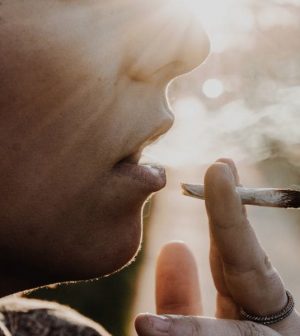- Navigating Your Midlife Crisis: Embracing New Possibilities
- City Raccoons Showing Signs of Domestication
- Mapping the Exposome: Science Broadens Focus to Environmental Disease Triggers
- One Week Less on Social Media Linked to Better Mental Health
- Your Brain Changes in Stages as You Age, Study Finds
- Some Suicide Victims Show No Typical Warning Signs, Study Finds
- ByHeart Formula Faces Lawsuits After Babies Sickened With Botulism
- Switch to Vegan Diet Could Cut Your Greenhouse Gas Emissions in Half
- Regular Bedtime Does Wonders for Blood Pressure
- Dining Alone Could Mean Worse Nutrition for Seniors
Secondhand Pot Smoke Found in Kids’ Lungs

If you’re a pot-smoking parent and you think your kids aren’t affected, think again.
New research found evidence of secondhand marijuana smoke exposure in nearly half of children whose parents smoke the drug.
“While the effects of tobacco smoke have been studied extensively, we are still learning about marijuana exposure,” said researcher Dr. Karen Wilson, from the Icahn School of Medicine at Mount Sinai in New York City.
“What we found in this study is that secondhand marijuana smoke does get into the lungs and little bodies of young children,” Wilson said in a school news release.
The study included parents in Colorado who used marijuana and was conducted after recreational use of the drug became legal in that state. Currently, 10 states permit recreational marijuana use and 33 allow medical use of the drug.
Among the parents in the study, smoking was the most common form of marijuana use (30 percent), followed by edibles (14.5 percent) and vaporizers (9.6 percent), the investigators found.
Urine samples were collected from the parents’ children. Those samples revealed that 46 percent of the youngsters had detectable levels of the marijuana metabolite tetrahydrocannabinol carboxylic acid (COOH-THC), and 11 percent had detectable levels of tetrahydrocannabinol (THC), the primary psychoactive ingredient in marijuana.
THC is an indicator of both recent and active exposure to marijuana, and a higher level of exposure overall.
“These are worrisome results, suggesting nearly half of the children of parents who smoke marijuana are getting exposed, and 11 percent are exposed to a much greater degree,” Wilson said.
Most parents (84 percent) said no one ever smoked marijuana inside their homes, while 7.4 percent said marijuana was smoked in their home daily, the researchers said.
When asked what happened if someone wanted to smoke marijuana in the home while the children were present, 52 percent of parents said there was no smoking when children were home, 22 percent stepped outside, and nearly one in 10 smoked in another room or another floor.
One-third of children whose parents stepped outside to smoke tested positive for COOH-THC, according to the report published online Nov. 19 in Pediatrics.
“Stepping outside might sound like a good idea, but the evidence we collected suggests that kids are still getting exposed through secondhand or possibly thirdhand smoke exposure,” Wilson said.
“We know that thirdhand smoke — smoke that lingers in our hair, our clothes, even our skin — results in biological exposure that we can detect. What remains unclear is the extent and consequence of this mechanism of exposure,” Wilson explained.
“Our findings suggest that smoking in the home, even in a different room, results in exposure to children. The more we understand secondhand and thirdhand smoke exposure, the better we can protect children in the home in states where marijuana is legal,” she added.
Tobacco and marijuana smoke contain similar harmful chemicals, the researchers noted.
The study authors pointed out that most states that permit marijuana use don’t allow it in public indoor and outdoor spaces, but do not have restrictions on smoking marijuana in the presence of children.
More information
The American Nonsmokers’ Rights Foundation has more on secondhand marijuana smoke.
Source: HealthDay
Copyright © 2025 HealthDay. All rights reserved.










